What's wrong with
this clutch and flywheel?
(hope you don't have one of these in your car!)
Recently, we have
seen hybrid clutch options from some vendors.
This design consists of organic material on one side and a
segmented carbon or ceramic material on the other. The
idea is that the organic side will help smooth the
engagement, reducing the shuddering that one would expect
from the segmented side.
On generally accepted principle, any chain is only as strong
as the weakest link. With that in mind, temperature and
hp range of this hybrid clutch is identical to organic.
It would not matter if the carbon/ceramic side were more
durable, the entire assembly is subject to the limits of the
organic side. Therefore, no racing or slip-resistance
advantage at all. As carbon/ceramic side will wear
flywheel or pressure plate surface faster (even moreso in
traffic situations), there is a distinct disadvantage to this
setup.
Gimmick?
Quite likely. The "hybrid" design appears to
be more of a marketing hook rather than an actual performance
advantage. The brand we examined, although it still
functioned, was on the way to failure due to bad
design. Flexation of the underlying clutch disk caused
uneven wear of the carbon/ceramic pucks, and was not
sufficiently stiff to hold the solid organic side against the
pressure plate. While the underlying structural disk
might have been sufficient for a full-area friction material,
it clearly was not when built with the puck design.
Unless requested for "safety check" purposes, we
have kept the vendor of this setup anonymous. All
manufacturer markings have been blurred out
Ever wonder how to turn over $1000 worth of flywheel and
clutch in to scrap? Follow these steps...
| |
Click
any pic for a larger view.
|
Carbon/ceramic side of clutch
disk. Note individual pucks. These are
the friction areas on this side of the disk.
Note excessive scoring. This clutch was mated
to an aluminum flywheel with an inferior grade of
steel for the friction surface. The flywheel
vendor sold this clutch as a package with the
flywheel, quite obviously unaware of the material
characteristics. Note the scoring on the pucks. |
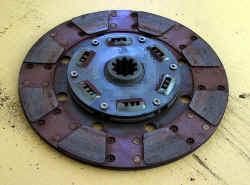 |
Another view of the pucks
showing scoring.
|
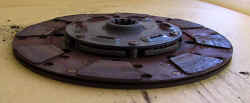 |
| Either inferior flywheel material or
flexation of the clutch disk caused dramatically
uneven wear of the flywheel. Note the
difference in material thickness between the inner
and outer diameter. With only 6,000 miles on
this clutch, it is doubtful that it would have
reached 10,000 miles before failing completely. |
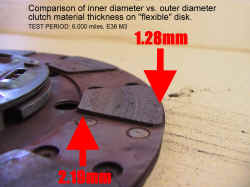 |
| This is the "matched"
flywheel. Note the blue discoloration of the
friction surface's outer diameter from heat and
wear. A high-grade steel friction surface would
not have suffered this damage. Like all
aluminum flywheels, this unit has a steel plate
bolted to an aluminum disk. However, note the
placement of the 12 bolts. See that large areas
of the plate are not fastened. Under high heat,
this will allow the plate to buckle and lift,
decreasing contact area and causing abnormal
wear. That problem is also one possibility as
to why the inner and outer diameters are
"blued" with heat to different degrees.
|
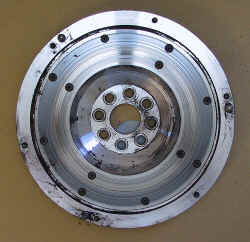 |
| Close-up view of the friction
surface. Note the deep grooves. This
flywheel friction surface is beyond repair. |
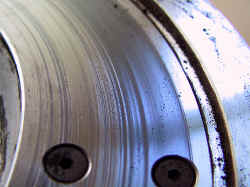 |
| This is the opposite side of the clutch
disk, the solid organic side. Note the
alternating shiny and dark areas, eight of
each. Not coincidentally, there are eight pucks
on the other side, whose positions correlate to the
shiny areas on this surface. What we see here is the
structural clutch disk plate flexing, causing the
dull areas to avoid contact with the pressure
plate. Effectively, only half of the organic
side was in contact, meaning the other half (the
shiny areas) were exposed to twice as much friction.
|
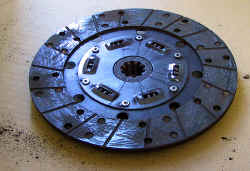 |
Same pic, circles mark the
areas that were not contacting.
|
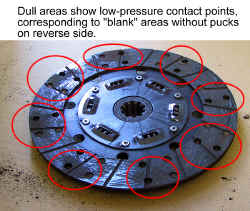 |






